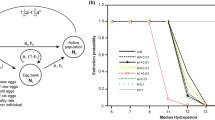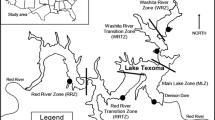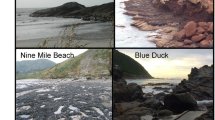Abstract
Invasive macroalgae form a substantial component of marine invaders at a global level. However, it is poorly understood how the complex interactions between local environmental conditions and life cycle dynamics contribute to invasion success from a mechanistic viewpoint. The aim of this study was to use a model (UndariaGEN) that incorporates a detailed representation of the individual heteromorphic life history stages (sporophytes and gametophytes) of the species in order to explore how interactions between these components contribute to the overall population dynamics. The latest version of the model was validated against field data from a real-life population in Brittany, France. This was followed by an assessment of the role of temperature limitations in determining its potential global range and then a more detailed examination of how environmental factors affect the life cycle dynamics of U. pinnatifida across a range of conditions characteristic of European populations. In terms of both relative abundance and recruitment, the model matches closely the patterns observed from field studies in Brittany, France (R2 = 0.98 respectively). Furthermore, the model predicted theoretical temperature limits for growth (9.1–22.5 °C) match closely the actual current global range limits for the species (9.5–22.4 °C) reported in the literature. In addition, the size of the species’ ecological niche is shown to be directly related to the amplitude in seasonal variation of temperature. This demonstrates that U. pinnatifida has a wider ecological niche in conditions of high seasonality; this finding is consistent with theories that propose the heteromorphic life cycle may have evolved as an optimal growth strategy for highly seasonal environments.






Similar content being viewed by others
References
Báez JC, Olivero J, Peteiro C et al (2010) Macro-environmental modelling of the current distribution of Undaria pinnatifida (Laminariales, Ochrophyta) in northern Iberia. Biol Invasions 12:2131–2139
Bessho K, Iwasa Y (2009) Heteromorphic and isomorphic alternations of generations in macroalgae as adaptations to a seasonal environment. Evol Ecol Res 11:691–711
Binzer T, Middelboe AL (2005) From thallus to communities: scale effects and photosynthetic performance in macroalgae communities. Mar Ecol Prog Ser 287:65–75
Broennimann O, Treier UA, Müller-Schärer H et al (2007) Evidence of climatic niche shift during biological invasion. Ecol Lett 10:701–709
Campbell SJ, Bité JS, Burridge TR (1999) Seasonal patterns in the photosynthetic capacity, tissue pigment and nutrient content of different developmental stages of Undaria pinnatifida (Phaeophyta: Laminariales) in Port Phillip Bay, South-Eastern Australia. Bot Marina 42:231
Carney LT, Edwards MS (2006) Cryptic processes in the sea: a review of delayed development in the microscopic life stages of marine macroalgae. Algae 21:161–168
Cecere E, Petrocelli A, Daniela Saracino O (2000) Undaria pinnatifida (Fucophyceae, Laminariales) spread in the central Mediterranean: its occurrence in the Mar Piccolo of Taranto (Ionian Sea, southern Italy). Cryptogam Algologie 21:305–309
Choi H, Kim Y, Lee S et al (2005) Effects of daylength, irradiance and settlement density on the growth and reproduction of Undaria pinnatifida gametophytes. J Appl Phycol 17:423–430
Choi H, Kim Y, Lee S et al (2007) Growth and reproductive patterns of Undaria pinnatifida sporophytes in a cultivation farm in Busan, Korea. J Appl Phycol 19:131–138
Clayton MN (1988) Evolution and life histories of brown algae. Bot Mar 31:379
Couceiro L, Peters A, Le Gac M et al (2013) The Ectocarpus life cycle in the field supports the hypothesis of niche separation between gametophytes and sporophytes. Phycologia 52:20–21
Curiel D, Bellemo G, Marzocchi M et al (1998) Distribution of introduced Japanese macroalgae Undaria pinnatifida, Sargassum muticum (Phaeophyta) and Antithamnion Pectinatum (Rhodophyta) in the Lagoon of Venice. Hydrobiologia 385:17–22
Curiel D, Guidetti P, Bellemo G et al (2002) The introduced alga Undaria pinnatifida (Laminariales, Alariaceae) in the lagoon of Venice. Hydrobiologia 477:209–219
Daguin C, Voisin M, Engel C et al (2005) Microsatellites isolation and polymorphism in introduced populations of the cultivated seaweed Undaria pinnatifida (Phaeophyceae, Laminariales). Conserv Genet 6:647–650
DeAngelis DL, Gross LJ (1992) Individual-based models and approaches in ecology: populations, communities and ecosystems. Chapman & Hall, London
Dellatorre FG, Amoroso R, Saravia J et al (2014) Rapid expansion and potential range of the invasive kelp Undaria pinnatifida in the Southwest Atlantic. Aquat Invasions 9:467–478
Ebenman B (1992) Evolution in organisms that change their niches during the life-cycle. Am Nat 139:990–1021
Eckert GL (2003) Effects of the planktonic period on marine population fluctuations. Ecology 84:372–383
Edwards MS (2000) The role of alternate life-history stages of a marine macroalga: a seed bank analogue. Ecology 81:2404–2415
Floc’h JY, Pajot R, Wallentinus I (1991) The Japanese brown alga Undaria pinnatifida on the coast of France and its possible establishment in European waters. Journal du Conseil ICES J Mar Sci 47:379–390
Grimm V, Railsback SF (2005) Individual-based modeling and ecology. Princeton University Press, Princeton
Grulois D, Lévêque L, Viard F et al (2011) Mosaic genetic structure and sustainable establishment of the invasive kelp Undaria pinnatifida within a bay (Bay of St-Malo, Brittany). CBM Cahiers de Biologie Marine 52:485
Hay CH, Luckens PA (1987) The Asian kelp Undaria pinnatifida (Phaeophyta: Laminariales) found in a New Zealand harbour. NZ J Bot 25:329–332
Higgins SI, Richardson DM (2014) Invasive plants have broader physiological niches. Proc Natl Acad Sci USA 111:10610–10614
INES (2015) Logiciel CALSOL. Institut National de L’Energie Solaire, France
INSU-CNRS (2015) SOMLIT—Service d’Observation en Milieu Littoral. Institut National des Sciences de l’Univers (CNRS), France
James K, Kibele J, Shears N (2015) Using satellite-derived sea surface temperature to predict the potential global range and phenology of the invasive kelp Undaria pinnatifida. Biol Invasions 17:3393–3408
Kearney M, Porter W (2009) Mechanistic niche modelling: combining physiological and spatial data to predict species’ ranges. Ecol Lett 12:334–350
Mackenzie BR, Schiedek D (2007) Daily ocean monitoring since the 1860s shows record warming of northern European seas. Glob Change Biol 13:1335–1347
Marcelino VR, Verbruggen H (2015) Ecological niche models of invasive seaweeds. J Phycol 51:606–620
Martin JP, Cuevas JM (2006) First record of Undaria Pinnatifida (Laminariales, Phaeophyta) in Southern Patagonia, Argentina. Biol Invasions 8:1399–1402
Matsumoto M, Nishimura T (1998) Mersenne twister: a 623-dimensionally equidistributed uniform pseudo-random number generator. ACM Trans Model Comput Simul 8:3–30
Minchin D, Nunn J (2014) The invasive brown alga Undaria pinnatifida (Harvey) Suringar, 1873 (Laminariales: Alariaceae), spreads northwards in Europe. BioInvasions Rec 3:57–63
Mineur F, Johnson MP, Maggs CA et al (2006) Hull fouling on commercial ships as a vector of macroalgal introduction. Mar Biol 151:1299–1307
Mineur F, Belsher T, Johnson MP et al (2007) Experimental assessment of oyster transfers as a vector for macroalgal introductions. Biol Conserv 137:237–247
Morita T, Kurashima A, Maegawa M (2003a) Temperature requirements for the growth and maturation of the gametophytes of Undaria pinnatifida and U. undarioides (Laminariales, Phaeophyceae). Phycol Res 51:154–160
Morita T, Kurashima A, Maegawa M (2003b) Temperature requirements for the growth of young sporophytes of Undaria pinnatifida and Undaria undarioides (Laminariales, Phaeophyceae). Phycol Res 51:266–270
Murphy JT (2016) UndariaGEN—a spatially-explicit agent-based model of macroalgae in the marine environment. https://github.com/murphyjtm/undariaGEN
Murphy JT, Johnson MP, Viard F (2016a) A modelling approach to explore the critical environmental parameters influencing the growth and establishment of the invasive seaweed Undaria pinnatifida in Europe. J Theor Biol 396:105–115
Murphy JT, Voisin M, Johnson M et al (2016b) Abundance and recruitment data for Undaria pinnatifida in Brest harbour, France: model versus field results. Data Brief 7:540–545
Nyberg C, Wallentinus I (2005) Can species traits be used to predict marine macroalgal introductions? Biol Invasions 7:265–279
Ohno M, Matsuoka M (1993) Undaria cultivation ‘wakame’. Seaweed cultivation and marine ranching. Kanagawa International Fisheries Training Center Japan International Cooperative Agency, Yokosuka, pp 41–49
Pang S, Lüning K (2004) Photoperiodic long-day control of sporophyll and hair formation in the brown alga Undaria pinnatifida. J Appl Phycol 16:83–92
Pang SJ, Shan TF, Zhang ZH (2008) Responses of vegetative gametophytes of Undaria pinnatifida to high irradiance in the process of gametogenesis. Phycol Res 56:280–287
Peteiro C (2008) A new record of the introduced seaweed Undaria pinnatifida (Laminariales, Phaeophyceae) from the Cantabrian Sea (northern Spain) with comments on its establishment. Aquat Invasions 3:413–415
Peterson AT (2003) Predicting the geography of species’ invasions via ecological niche modeling. Q Rev Biol 78:419–433
Saito Y (1975) Undaria. Advance of phycology in Japan. Junk Publishers, The Hague, pp 304–320
Saulquin B, Hamdi A, Gohin F et al (2013) Estimation of the diffuse attenuation coefficient KdPAR using MERIS and application to seabed habitat mapping. Remote Sens Environ 128:224–233
Shao-jun P, Chao-yuan W (1996) Study on gametophyte vegetative growth of Undaria pinnatifida and its applications. Chin J Oceanol Limn 14:205–210
Silva P, Woodfield R, Cohen A et al (2002) First Report of the Asian kelp Undaria pinnatifida in the Northeastern Pacific Ocean. Biol Invasions 4:333–338
Spalding MD, Fox HE, Allen GR et al (2007) Marine ecoregions of the world: a bioregionalization of coastal and shelf areas. Bioscience 57:573–583
Suto S (1952) On shedding of zoospores in some algae of Laminariaceae-2. Bull Jpn Soc Sci Fish 18:1–5
Thornber CS (2006) Functional properties of the isomorphic biphasic algal life cycle. Integr Comp Biol 46:605–614
Thornber CS, Kinlan BP, Graham MH et al (2004) Population ecology of the invasive kelp Undaria pinnatifida in California: environmental and biological controls on demography. Mar Ecol Prog Ser 268:69–80
Urban MC, Phillips BL, Skelly DK et al (2007) The cane toad’s (Chaunus [Bufo] marinus) increasing ability to invade Australia is revealed by a dynamically updated range model. Proc R Soc Lond B Biol Sci 274:1413–1419
USNO (2015) Table of sunrise/sunset for an entire year. US Naval Observatory Astronomical Applications Department, Washington
Voisin M (2007) Les processus d’invasions biologiques en milieu côtier marin: le cas de l’algue brune Undaria pinnatifida, cultivée et introduite à l’échelle mondiale (Ph.D. diss.). Paris 6, France
Voisin M, Engel CR, Viard F (2005) Differential shuffling of native genetic diversity across introduced regions in a brown alga: aquaculture vs. maritime traffic effects. Proc Natl Acad Sci USA 102:5432–5437
Wallentinus I (2007) Alien species alert: Undaria pinnatifida (wakame or Japanese kelp). ICES Cooperative Research Report
Yesson C, Bush LE, Davies AJ et al (2015) The distribution and environmental requirements of large brown seaweeds in the British Isles. J Mar Biol Assoc UK 95:669–680
Acknowledgements
This research is supported by an Irish Research Council ELEVATE international career development fellowship, co-funded by Marie Curie Actions under the European Union’s Seventh Framework Programme. The field data presented here, which were collected in Brest, were obtained as part of the Ph.D. thesis of Marie Voisin who benefitted from a Ph.D. fellowship (“Renouvellement des Compétences” Program) from the Region Bretagne. MV and FV are thankful to the many people from the Department AD2M of the Station Biologique de Roscoff who provided help for the surveys carried out in the field.
Author information
Authors and Affiliations
Corresponding author
Electronic supplementary material
Below is the link to the electronic supplementary material.
Rights and permissions
About this article
Cite this article
Murphy, J.T., Johnson, M.P. & Viard, F. A theoretical examination of environmental effects on the life cycle schedule and range limits of the invasive seaweed Undaria pinnatifida . Biol Invasions 19, 691–702 (2017). https://doi.org/10.1007/s10530-016-1357-1
Received:
Accepted:
Published:
Issue Date:
DOI: https://doi.org/10.1007/s10530-016-1357-1




